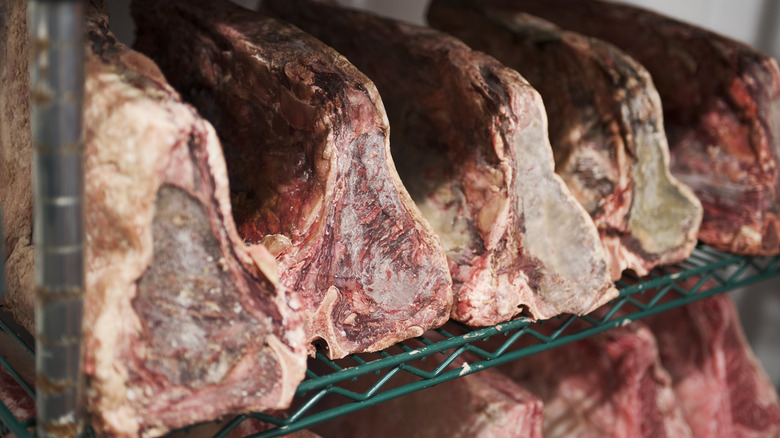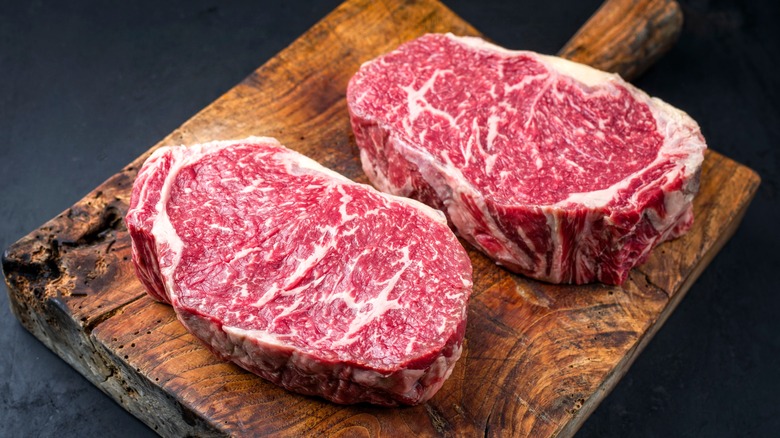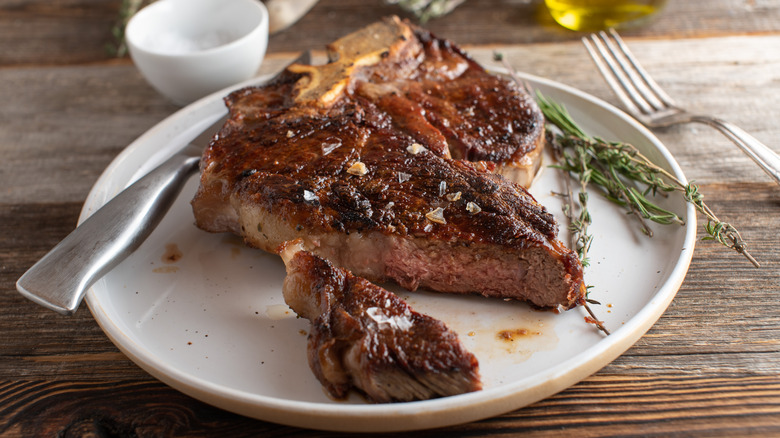You Probably Aren't Dry Aging Your Meat For Long Enough
Dry aging is something you might hear discussed in relation to upscale butcher counters and expensive steak restaurants. The process, which involves letting meat sit out in a temperature-controlled area for an extended period of time, leads to a decadently tender final product. But it isn't just a process reserved for the rich; there are people who attempt to dry-age their beef at home, doing so in the refrigerator with simple rigs built from kitchen equipment.
But a four-day stint in the fridge just isn't going to cut it if you want to see and taste the difference. According to meat expert Mark Pastore of LaFrieda Meat Purveyors, four days simply isn't enough to make the magic happen. "For dry-aged beef, you need to go 21 days at a bare minimum for any noticeable changes," he said in an interview with Serious Eats. Any shorter than that, and the meat won't have enough time to go through the various processes of drying and enzymatic breakdown that give dry-aged steak its signature look and taste.
What is dry-aging?
Most meat is dry-aged in a temperature-controlled chamber, either situated on racks or hung from a hook. The ideal temperature to dry-age meat at is around 35 degrees Fahrenheit, with a humidity level of around 85-90 percent.
The dry-aging process changes meat at a structural level. As the meat sits out and air-dries, it's slowly sapped of its moisture — up to 30% of its size in water can be sapped away over the course of aging. This deepens the flavor and makes the meat itself shrink in size, so most start with a larger piece of meat.
As the meat sits out, enzymes begin to break down and relax the muscle fibers in the meat, tenderizing everything and making it all supple and soft. Those same enzymatic processes, along with bacteria in the ambient atmosphere, can also change the flavor of the meat itself, giving the final product almost a nutty or blue cheese-like taste and aroma.
Can you truly dry-age meat at home?
Given the amount of time needed to truly dry-age meat properly and the temperature and humidity control needed to ensure the process doesn't go south and the meat doesn't spoil, is it possible to dry-age meat at home? While you can certainly salt a steak and leave it out on a cooling rack in your fridge for a few days to dry out, this won't yield remotely the same results as a professionally dry-aged cut of beef. Sure, it'll help the steak brown better, but those enzymes won't have enough time to do their work on the meat muscles. And letting that meat sit for too long without complete control over temperature, humidity, and airflow can have rotten results.
Now, there are ways to safely attempt dry-aging at home if you're dedicated to it, from vacuum-sealing your meat cuts to purchasing an appliance built specifically for dry-aging. But even beyond just the challenges of figuring out where and how to store your beef, most dry-aged meats aren't aged per cut but in large chunks, such as entire sections of rib. That can get costly quickly, especially if you add in boutique equipment as well. So, if you really want a mouthful of that flavor that only a proper dry-aging can provide, we recommend you stick with purchasing pre-aged meats from the experts.


